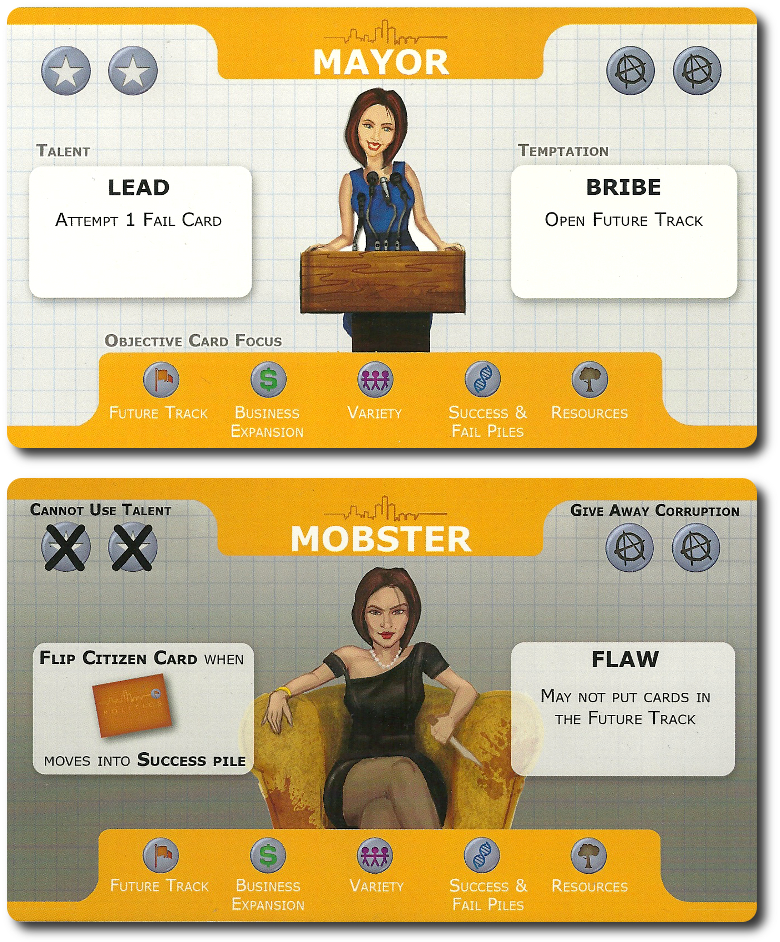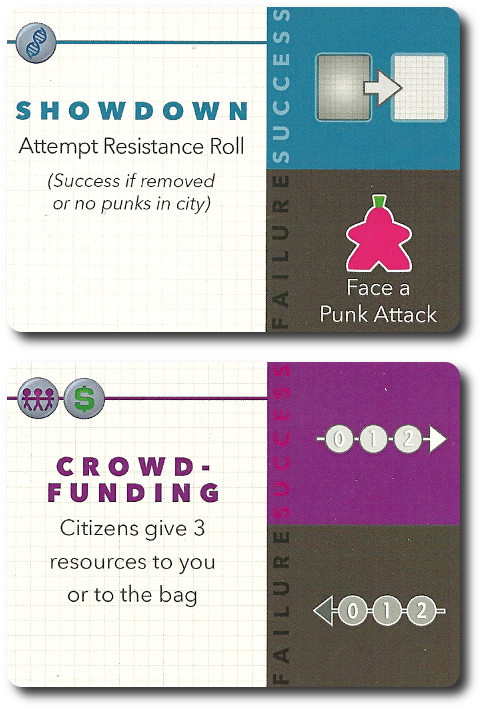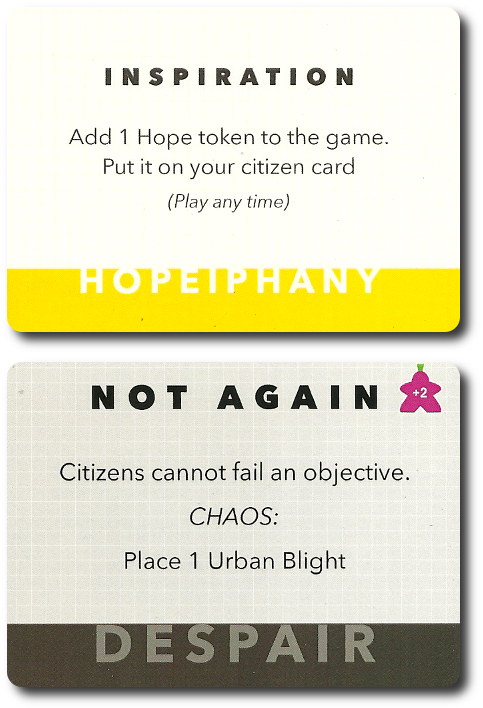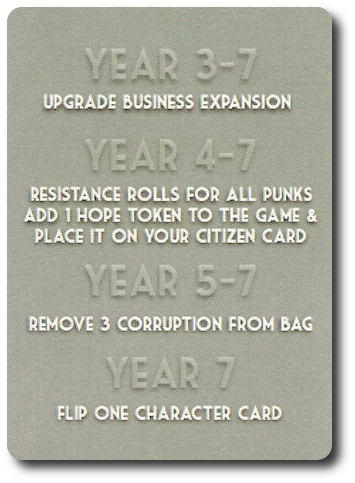Please Take Note: This is a review of the final game, but it might change slightly based on the success of the Kickstarter campaign. The game is being reviewed on the components and the rules provided with the understanding that “what you see is not what you might get” when the game is published. If you like what you read and want to learn more, we encourage you to visit the game publisher’s website or visit the Kickstarter campaign. Now that we have all that disclaimer junk out of the way, on with the review.

The Basics:
- For ages 10 and up (publisher suggests 13+)
- For 3 to 6 players
- Approximately 180 minutes to complete
Geek Skills:
- Active Listening & Communication
- Counting & Math
- Logical & Critical Decision Making
- Reading
- Pattern/Color Matching
- Strategy & Tactics
- Risk vs. Reward
- Cooperative & Team Play
- Hand/Resource Management
- Worker Placement & Area Control
Learning Curve:
- Child – Easy
- Adult – Easy
Theme & Narrative:
- Rescue the city from itself and you
Endorsements:
- Gamer Geek mixed!
- Parent Geek approved!
- Child Geek approved!
Overview
American economist, Alan Greenspan, said, “Corruption, embezzlement, fraud, these are all characteristics which exist everywhere. It is regrettably the way human nature functions, whether we like it or not. What successful economies do is keep it to a minimum. No one has ever eliminated any of that stuff.” Crime and chaos are always at our doors. The fabric of society is only as strong as those who work to keep it mended. But even the strongest can fall. What is never lost is hope and hope makes it all possible.
Hope City, designed by Robert Mattox and to be published by Dux Nova, will reportedly be comprised of 1 game board, 8 dice, 1 Citizen Wage bag, 6 Citizen boards, 5 City Sites, 5 Urban Blights, 8 Punk meeples, 2 Big Punk meeples, 6 Player meeples, 70 Objective cards, 2 marker tokens, 20 Corruption tokens, 30 Resource tokens, 3 Hope tokens, 18 Talent tokens, 1 Summary sheet, 1 Phoenix Monument miniature, and 1 Phoenix Monument card. As this is a review of a prepublished game, I cannot comment on the game component quality.
The Sun Rises Over the City
To set up the game, first place the game board in the middle of the playing area and within easy reach of all the players.
Second, have each player select a Citizen board or randomly deal them out. The “Mayor” must be used during each game by default. Place any Citizen boards not used to one side of the game board. These inactive Citizen boards can be used later in the game. Flip the Citizen boards so the non-corrupted side is face-up. Give each players 2 Talent tokens.
Third, place 3 resources of each color and Corruption tokens in the Citizen Wage bag. Give each player 1 random token from the bag.
Fourth, place 1 Resource of each color and 1 Hope token in the Trade Center found on the game board.
Fifth, place 1 Chaos card face down on the “T” on the Future track found on the game board.
Sixth, place a yellow Marker token on the Business Expansion “Level 0” and a Marker on “Year 1” tracks found on the game board.
Seventh, place the Objective cards at the top of the game board and place the Major Objective cards (those that cost 5 or more resources) in a separate pile with the first card face-up.
Eighth, place 1 Punk meeple on Politics and 1 Punk meeple on the Economics spaces found on the game board.
Ninth, place 5 Hope cards and 9 Chaos cards on the game board. Place City Site/Urban Blight tiles, the Phoenix Monument card (with miniature), any extra tokens, dice, and Punks to one side of the game board.
That’s it for game set up. Determine who will go first (always the Mayor) and begin to build or destroy the city.
The Sin of the City
Hope City is played in rounds and turns. A typical round and player turn is summarized here.
At the start of each round (considered a “Year”), a new Chaos card is brought into play. If there are no Punks on the game board, 2 are placed. If only 1 Punk is present, then only 1 additional Punk is added.
A player’s turn (always starting with the Mayor) consists of 9 sequential steps.
Step 1: Take Citizen Wage
One token is drawn from the Citizen Wage bag at random.
Step 2: Trade
The player can now trade 1 Resource token located in the Trade Center. This step is optional.
Step 3: Move
The player can move to a specific City space on the game board. Again this step is optional.
Step 4: Face Those Dirty Punks
If there are any Punk meeples on the game board, the player can attempt to deal with them.
Step 5: Select Objective
The player selects an Objective card that matches the City space they are currently located in. This will be an Objective pile of cards, the Future track, or the Fail pile.
Step 6: Pay Up
The player must pay the cost of the Objective card and then attempt to meet the specified conditions noted on the card. If the card is not paid for in full (either because the player cannot pay or chooses not to), the card is placed on the Future track.
Step 7: Achievement!
If the player can achieve their goal and meet the conditions, they take 1 Hope card that matches the objective color.
Step 8: Resolve
Success is now resolved or the possible failure. The Objective cards state what must be done.
Step 9: Card Placement
The card is now placed in the appropriate Success or Fail pile on the game board.
At the end of the round and only after all players have had a turn, the Chaos cards are resolved and the Citizen Wage bag is infected with 1 Corruption token for every Punk meeple still on the game board.
Breaking Bad
Each player starts with a Citizen who wants to do the right thing and is full of optimism. Fools. This won’t last long. As the game plays out, the players will collect Corruption tokens. If the player collects enough, their Citizen board goes from “good” to “corrupt”. In game terms, the Citizen changes from an asset to a detrimental road block. Their very presence helps sink the City deeper into despair. The good news is that redemption is possible.

Each character will change when they flip. It’s up to the players to decide how best to use the new “talents” of their corrupted state. Just keep in mind that every character, no matter how bad they break, can always be brought back into the fold of justice. Redemption might only be a few turns away.
Meeting Objectives
The primary goal of the game is to meet objectives. While punks are a threat to be sometimes tolerated and more times squashed, the real focus should be completing objectives so the City can grow and prosper. Objectives fall into the categories of Politics, Economics, Society, Technology, and Environment. Each Objective has a “cost” that must be paid. Consider this the investment in a project. Once the project is funded, the Objective has a condition that must be met before the Objective itself is complete. For example, funding a park is great, but you have to make certain that no Punks are there to ruin the kids’ day.

Hope and Chaos
Hope cards are a powerful boon for the players. They improve conditions and even bolster the effects of certain objectives, making simple projects into major renovations for the City. On the opposite side are the Chaos cards that thwart all attempts to raise the City and its Citizens above the grime and crime.

An Uncertain Future
The Future track is a powerful planning tool for the players. It allows them to place projects for the future that cannot be completed due to lack of resources. Rather than lose the opportunity to play the card, placing it on the Future track means it can be tackled at a later time. But the future is not unlimited. If the Future track gets too full, projects will start to fall off and opportunities will be lost.
The Rise of the Phoenix
The Phoenix monument is a symbol to all citizens that anyone can rise above the trials and tribulations of life. In game terms, it serves as a bonus that improves the players’ chances of winning, but the bonus itself is based on when the monument is built. As such, building the monument late in the game provides a great number of bonuses, but some that might be too late to be of any benefit. Building the monument too early will give the players a proper boost in the right direction, but it won’t be beneficial for long.

Winning or Losing the City
The players have 7 rounds (7 years) to win the game. If they place 3 or more City Site cards on the game board by completing Objectives and removing Punks, they win. City Sites can be lost, so players will need to protect that which they have struggled to build. The players can also win if they place 5 City Sites and the Mobster and Drug Dealer are not in play.
On the other hand, the players will lose at the end of the 7th year if they have failed to meet their victory objective. The game is automatically lost if the City has 5 Urban Blights, all Citizen boards are corrupted, or all the Objective cards of 1 category are in the Fail pile.
To learn more about Hope City, view the game publisher’s Facebook page.
Final Word
 The Child Geeks most favorite thing about the game was fighting the Punks. According to one Child Geek, “If you divide up your players into fighters and fixers, the game is pretty easy. One group focuses on tackling crime while the others work on improving the city. I always want to fight the crime and kick some punk butt!” Another Child Geek said, “I like how you can see the city slowly fall into trouble. That helps you decide where to put your energy into rescuing certain parts of the area.” The second most favorite thing was the corruption of their characters. They found it strangely interesting to turn “bad” and then loved it when they turned “good”. When the games were over, regardless if the city was saved or not, the Child Geeks voted to approve Hope City.
The Child Geeks most favorite thing about the game was fighting the Punks. According to one Child Geek, “If you divide up your players into fighters and fixers, the game is pretty easy. One group focuses on tackling crime while the others work on improving the city. I always want to fight the crime and kick some punk butt!” Another Child Geek said, “I like how you can see the city slowly fall into trouble. That helps you decide where to put your energy into rescuing certain parts of the area.” The second most favorite thing was the corruption of their characters. They found it strangely interesting to turn “bad” and then loved it when they turned “good”. When the games were over, regardless if the city was saved or not, the Child Geeks voted to approve Hope City.
 The Parent Geeks enjoyed the game a great deal, too. Especially when playing with their peers, but they found fun playing it with their family, as well. According to one Parent Geek, “This is a fun cooperative game. I really like how you have to take risks, but the rewards are clear. It makes the decision making easier, but not necessarily obvious.” Another Parent Geek said, “I think I like how the characters turn into bad people the best. Take on too much risk, fight too much crime, and the very thing you are attempting to thwart might consume you. Kind of like that looking into the Abyss quote said by Batman.” Friedrich Wilhelm Nietzsche, actually, but Batman said it, too. Just not originally. None of the Parent Geeks found any flaws in the game and thoroughly enjoyed themselves. They had zero problem voting to approve Hope City.
The Parent Geeks enjoyed the game a great deal, too. Especially when playing with their peers, but they found fun playing it with their family, as well. According to one Parent Geek, “This is a fun cooperative game. I really like how you have to take risks, but the rewards are clear. It makes the decision making easier, but not necessarily obvious.” Another Parent Geek said, “I think I like how the characters turn into bad people the best. Take on too much risk, fight too much crime, and the very thing you are attempting to thwart might consume you. Kind of like that looking into the Abyss quote said by Batman.” Friedrich Wilhelm Nietzsche, actually, but Batman said it, too. Just not originally. None of the Parent Geeks found any flaws in the game and thoroughly enjoyed themselves. They had zero problem voting to approve Hope City.
 The Gamer Geeks, being the elitists that they are, were pretty hard on Hope City. While they found no game flaws, they were not overly happy with the game’s level of difficulty or flow. According to one Gamer Geek, “The game feels a bit clumsy and clunky to me. Too many steps in a player’s turn. I would have preferred to see the game more streamlined so it didn’t take so long. I think it stays on the table a bit too long as it currently is.” Another Gamer Geek said, “I think the game is OK, but not great. It feels repetitive after a bit, even though the risks are always different. I can’t put my finger on it, but there is a sameness throughout that just nags me. Not necessarily boring, but I do lose interest quickly.” To be clear, the Gamer Geeks found no real big problems, but all agreed that the game fell short of their expectations. As such, the Gamer Geeks were torn. Some voted to approve, while others couldn’t overlook some of the faults. The end result was a mixed vote of approval.
The Gamer Geeks, being the elitists that they are, were pretty hard on Hope City. While they found no game flaws, they were not overly happy with the game’s level of difficulty or flow. According to one Gamer Geek, “The game feels a bit clumsy and clunky to me. Too many steps in a player’s turn. I would have preferred to see the game more streamlined so it didn’t take so long. I think it stays on the table a bit too long as it currently is.” Another Gamer Geek said, “I think the game is OK, but not great. It feels repetitive after a bit, even though the risks are always different. I can’t put my finger on it, but there is a sameness throughout that just nags me. Not necessarily boring, but I do lose interest quickly.” To be clear, the Gamer Geeks found no real big problems, but all agreed that the game fell short of their expectations. As such, the Gamer Geeks were torn. Some voted to approve, while others couldn’t overlook some of the faults. The end result was a mixed vote of approval.
 Like most Cooperative games, Hope City has the players manage the threat. In this case, the threat is corruption and chaos. But there is also a mores subtle and even bigger threat to the players and that is ambition. Nothing is stopping a player from attempting to tackle big objectives in hopes of making big impacts. The problem is, if they fail to achieve and meet the requirements, their attempt blows up in their face. A player who is looking to do good could send the game into a detrimental tailspin from which recovery might not be possible. I really liked this as it made each decision the players attempted heavily laced with risk versus reward. Do I attempt to clean up the park in hopes of making a small difference or do I take the fight to the streets and face the Punks on their own turf? Both will benefit me, but which do I risk? Failure is always possible as is corruption. The only question that ever needs be answered is “how much am I willing to lose?”
Like most Cooperative games, Hope City has the players manage the threat. In this case, the threat is corruption and chaos. But there is also a mores subtle and even bigger threat to the players and that is ambition. Nothing is stopping a player from attempting to tackle big objectives in hopes of making big impacts. The problem is, if they fail to achieve and meet the requirements, their attempt blows up in their face. A player who is looking to do good could send the game into a detrimental tailspin from which recovery might not be possible. I really liked this as it made each decision the players attempted heavily laced with risk versus reward. Do I attempt to clean up the park in hopes of making a small difference or do I take the fight to the streets and face the Punks on their own turf? Both will benefit me, but which do I risk? Failure is always possible as is corruption. The only question that ever needs be answered is “how much am I willing to lose?”
Another aspect of the game I very much enjoyed is the “breaking” of the Citizens. This was a neat twist in the game that served to remind the players that they were vulnerable to the very corruption and crime they were fighting. This added another level of risk with the only reward being continued effectiveness in the game. If the player’s Citizen flipped to corruption, it went from valuable asset to a detrimental necessary evil that hurt progress. It never once slowed down the game, however, and made the difficulty and the reward all the greater. Indeed, the game became more interesting the worse off the players were, as they now had to not only fight to save the City but to save their partners, as well.
As Cooperative games go, Hope City is a fun one, if not a bit repetitive in nature. There is enough to consider and enough changes in the game to keep the players shifting their focus and making new plans. The outcomes are always the same though, meaning the paths might shift a bit, but the end results are always familiar. How the players tackle the random threats will never change, but the order in which they must tackle them most certainly will. Do try to save the city when time permits.
This is a paid for review of the game’s final prototype. Although our time and focus was financially compensated, our words are our own. We’d need at least 10 million dollars before we started saying what other people wanted. Such is the statuesque and legendary integrity of Father Geek which cannot be bought except by those who own their own private islands and small countries.



